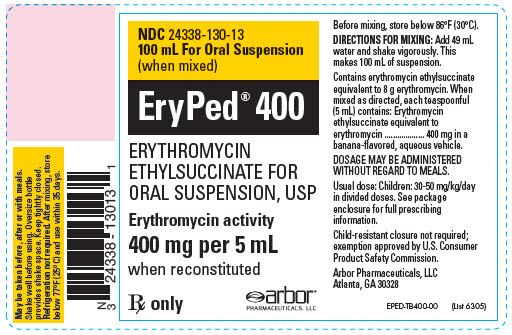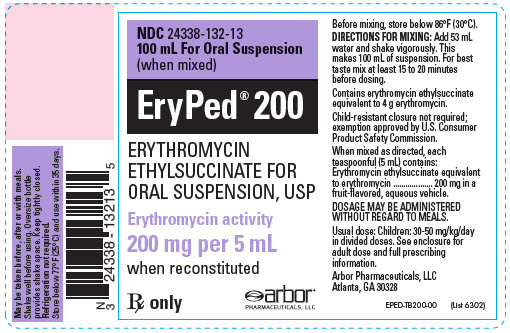For most of the drugs advantages of taking medications overweighs the potential risks however some drugs could be really dangerous for breastfed baby hence every medication shall be considered separately. In this page we will discuss about purpose of Ery-ped | Erythromycin Ethylsuccinate Suspension and its risk associated with lactation. We will also discuss the usage of Ery-ped | Erythromycin Ethylsuccinate Suspension and some common side effects associated with Ery-ped | Erythromycin Ethylsuccinate Suspension.
What is Ery-ped | Erythromycin Ethylsuccinate Suspension used for?
To reduce the development of drug-resistant bacteria and maintain the effectiveness of Ery-Ped and other antibacterial drugs, Ery-Ped should be used only to treat or prevent infections that are proven or strongly suspected to be caused by susceptible bacteria. When culture and susceptibility information are available, they should be considered in selecting or modifying antibacterial therapy. In the absence of such data, local epidemiology and susceptibility patterns may contribute to the empiric selection of therapy. Ery-Ped is indicated in the treatment of infections caused by susceptible strains of the designated organisms in the diseases listed below: Upper respiratory tract infections of mild to moderate degree caused by Streptococcus pyogenes, Streptococcus pneumoniae, or Haemophilus influenzae (when used concomitantly with adequate doses of sulfonamides, since many strains of H. influenzae are not susceptible to the erythromycin concentrations ordinarily achieved). (See appropriate sulfonamide labeling for prescribing information.) Lower-respiratory tract infections of mild to moderate severity caused by Streptococcus pneumoniae or Streptococcus pyogenes. Listeriosis caused by Listeria monocytogenes. Pertussis (whooping cough) caused by Bordetella pertussis. Erythromycin is effective in eliminating the organism from the nasopharynx of infected individuals rendering them noninfectious. Some clinical studies suggest that erythromycin may be helpful in the prophylaxis of pertussis in exposed susceptible individuals. Respiratory tract infections due to Mycoplasma pneumoniae. Skin and skin structure infections of mild to moderate severity caused by Streptococcus pyogenes or Staphylococcus aureus (resistant staphylococci may emerge during treatment). Diphtheria Infections due to Corynebacterium diphtheriae, as an adjunct to antitoxin, to prevent establishment of carriers and to eradicate the organism in carriers. Erythrasma In the treatment of infections due to Corynebacterium minutissimum. Intestinal amebiasis caused by Entamoeba histolytica (oral erythromycins only). Extraenteric amebiasis requires treatment with other agents. Acute Pelvic Inflammatory Disease Caused by Neisseria gonorrhoeae As an alternative drug in treatment of acute pelvic inflammatory disease caused by N. gonorrhoeae in female patients with a history of sensitivity to penicillin. Patients should have a serologic test for syphilis before receiving erythromycin as treatment of gonorrhea and a follow-up serologic test for syphilis after 3 months. Syphilis Caused by Treponema pallidum Erythromycin is an alternate choice of treatment for primary syphilis in penicillin-allergic patients. In primary syphilis, spinal fluid examinations should be done before treatment and as part of follow-up after therapy. Erythromycins are indicated for the treatment of the following infections caused by Chlamydia trachomatis Conjunctivitis of the newborn, pneumonia of infancy, and urogenital infections during pregnancy. When tetracyclines are contraindicated or not tolerated, erythromycin is indicated for the treatment of uncomplicated urethral, endocervical, or rectal infections in adults due to Chlamydia trachomatis. When tetracyclines are contraindicated or not tolerated, erythromycin is indicated for the treatment of nongonococcal urethritis caused by Ureaplasma urealyticum. Legionnaires' Disease caused by Legionella pneumophila. Although no controlled clinical efficacy studies have been conducted, in vitro and limited preliminary clinical data suggest that erythromycin may be effective in treating Legionnaires' Disease. Prophylaxis Prevention of Initial Attacks of Rheumatic Fever Penicillin is considered by the American Heart Association to be the drug of choice in the prevention of initial attacks of rheumatic fever (treatment of Streptococcus pyogenes infections of the upper respiratory tract, e.g., tonsillitis or pharyngitis). Erythromycin is indicated for the treatment of penicillin-allergic patients.1 The therapeutic dose should be administered for 10 days. Prevention of Recurrent Attacks of Rheumatic Fever Penicillin or sulfonamides are considered by the American Heart Association to be the drugs of choice in the prevention of recurrent attacks of rheumatic fever. In patients who are allergic to penicillin and sulfonamides, oral erythromycin is recommended by the American Heart Association in the long-term prophylaxis of Streptococcal pharyngitis (for the prevention of recurrent attacks of rheumatic fever).1
Is using Ery-ped | Erythromycin Ethylsuccinate Suspension unsafe in breastfeeding? Can there be bad consequences for baby if I use it while breastfeeding?
Ery-ped | Erythromycin Ethylsuccinate Suspension contains only one active ingredient that is Erythromycin. We have analyzed the usage of Erythromycin in breastfeeding and our analysis suggest that Erythromycin poses Low risk for infant while breastfeeding and hence Ery-ped | Erythromycin Ethylsuccinate Suspension itself shall be considered Low risk item for breastfeeding.
Statement of Manufacturer/Labeler about breastfeeding usage
Nursing Mothers Erythromycin is excreted in human milk. Caution should be exercised when erythromycin is administered to a nursing woman.
Ery-ped | Erythromycin Ethylsuccinate Suspension Breastfeeding Analsys
Low RiskCAS Number: 114-07-8
Excreted in very low levels into breast milk. Commonly used for pediatric treatment of small babies; it is very well tolerated by infants. Erythromycin is a macrolide that has been related to hypertrophic pyloric stenosis after early exposition through the breast milk. Avoiding its use in the first post-partum month would be a cautious measure. Be aware of the possibility of false negative results of bacterial cultures when the mother is on antibiotics. Also, diarrheal disease due to imbalance of intestinal flora is possible Small doses used for treatment of dermatologic and ophthalmologic conditions, together with a very low level in the mother’s plasma make very unlikely a significant excretion into breast milk. Topically used Erythromycin is safe while breastfeeding. Systemic treatments would be safer after the first month of life. The American Academy of Pediatrics rates it usually compatible with breastfeeding. List of Essential Medicines WHO 2002: Compatible with breastfeeding.
Ery-ped | Erythromycin Ethylsuccinate Suspension Breastfeeding Analsys - 2
CAS Number: 114-07-8

Because of the low levels of erythromycin in breastmilk and safe administration directly to infants, it is acceptable in nursing mothers. The small amounts in milk are unlikely to cause adverse effects in the infant. Monitor the infant for irritability and possible effects on the gastrointestinal flora, such as diarrhea, candidiasis (thrush, diaper rash). One case report and unconfirmed epidemiologic evidence indicates that the risk of hypertrophic pyloric stenosis in infants might occur during maternal use of erythromycin during breastfeeding; however, if it occurs, the frequency is very low. Infant side effects are unlikely with topical application for acne, although topical application to the nipple may increase the risk of diarrhea in the infant. Only water-miscible cream or gel products should be applied to the breast because ointments may expose the infant to high levels of mineral paraffins via licking.[1]
What should I do if I am breastfeeding mother and I am already exposed to Ery-ped | Erythromycin Ethylsuccinate Suspension?
Ery-ped | Erythromycin Ethylsuccinate Suspension is in the category of low risk, if you have already used it then its not a big deal if health and behavior of baby is good. However your health care provider shall be aware of the fact that you have used Ery-ped | Erythromycin Ethylsuccinate Suspension so you should inform him based on your convenience.
My health care provider has asked me to use Ery-ped | Erythromycin Ethylsuccinate Suspension, what to do?
Though Ery-ped | Erythromycin Ethylsuccinate Suspension dose not comes in category of safe drugs rather it comes in category of low risk but if your doctor is aware that you are breastfeeding your baby and has still recommended it then its advantages must be outweighing the risks.
If I am using Ery-ped | Erythromycin Ethylsuccinate Suspension, will my baby need extra monitoring?
Not much monitoring required while using Ery-ped | Erythromycin Ethylsuccinate Suspension
Who can I talk to if I have questions about usage of Ery-ped | Erythromycin Ethylsuccinate Suspension in breastfeeding?
US
National Womens Health and Breastfeeding Helpline: 800-994-9662 (TDD 888-220-5446) 9 a.m. and 6 p.m. ET, Monday through Friday
UK
National Breastfeeding Helpline: 0300-100-0212 9.30am to 9.30pm, daily
Association of Breastfeeding Mothers: 0300-330-5453
La Leche League: 0345-120-2918
The Breastfeeding Network supporter line in Bengali and Sylheti: 0300-456-2421
National Childbirth Trust (NCT): 0300-330-0700
Australia
National Breastfeeding Helpline: 1800-686-268 24 hours a day, 7 days a week
Canada
Telehealth Ontario for breastfeeding: 1-866-797-0000 24 hours a day, 7 days a week



